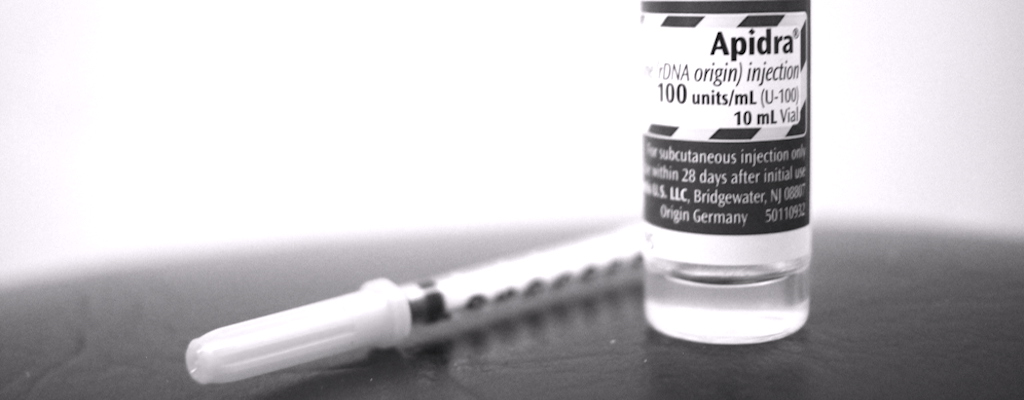The Switch: How I accidentally Found the Right Insulin
Note: This article is a part of our library of resources in Tools & How to. Check out more helpful product reviews and run downs on different diabetes management devices here.
One of the unfortunate realities of being a person with type 1 diabetes in the American healthcare system is that we don’t always have control of the medications we receive. I’ve changed insulin back and forth from Novolog to Humalog over my time with the pump due merely to the preference of my insurance company at the time. While those two insulins were nearly identical based on my blood sugar levels, I recently was put on a new insulin for the reason that it is the only insulin my new insurance covered.
That insulin is Apidra, an insulin I had never even heard mentioned by my doctors despite it being on the market since 2004. At first I didn’t know much about the new insulin, except that it was similar to Humalog, the insulin I had previously been prescribed. I was told it was slightly faster acting, but my dosages for carbohydrates and lowering my blood sugar shouldn’t change by much. While fairly skeptical about the new insulin I chose my first few meals carefully (low carbs, high fiber) and monitored my blood sugar closely.
Everything seemed fine and similar to Humalog, so I figured it was just the same medicine with a new name/logo. Then after a few days I tested the insulin against a high carbohydrate sandwich from one of my favorite sandwich places. These sandwiches are not what I would call “diabetic friendly” as the bread rolls are massive, clocking in an estimated 100-120 grams of carbohydrates for my preferred roll, Dutch Crunch. What happened next was surprising.
In my experience eating anything over 100 grams of carbohydrates in a single meal, I would always have a post meal slow-down, mostly due to the spike in blood sugar levels. I tried many ways to avoid this: taking the insulin earlier, taking more insulin, using the pump settings like “square-wave bolus” and “dual wave-bolus,” but nothing ever quite worked. Seemed like no matter what I did, I seemed to have a blood sugar spike an hour to two hours later, and if I tried to take more insulin when it spiked, I’d just have a low later.
So I eat the sandwich completely expecting the post meal slump. Except the slump never came. My sugars stayed steady and I actually felt fine. I thought it might be a fluke or something so I followed up the next day with a meal from a local Chinese restaurant, which was also notorious for putting me into a post meal funk. Again, I took dose of Apidra identical to a dose of Humalog that I would take to cover the same amount of carbs, and again I felt fine and had nearly no spike in blood sugar.
Now these meals I describe are meals I generally would avoid, specifically because of the spikes that would ensue. I had basically moved on from high carb meals in general and had been eating a protein and vegetable diet for quiet some time when cooking at home. However, sometimes I just feel the need to indulge in some of my favorite foods regardless of the consequence—a guilty pleasure I pay for almost immediately every time.
Now I feel the freedom to eat without the payback. Suddenly some of my favorite meals are back on the menu. Yes, I’ll have the fries with the burger. I’ll order the lasagna, thank you. Not that I’ll be eating heavy Italian meals every day, but having the freedom to choose almost anything on the menu again is a huge change in my outlook on my diet and relationship with food. Upon further research I found that Apidra and Humalog, while similar are not the same for everyone. Some people prefer Humalog, some prefer Apidra, others notice pretty much no difference. Well, everyone has a different metabolism and insulin should cater to that. My metabolism is quite fast, so these high carbohydrate meals would break down quicker than the insulin could get to me. My metabolism didn’t match my insulin, and for awhile I didn’t even think there could be a solution. I thought Novolog, Humalog and this new insulin I hadn’t even heard of were all the same and that was why they would change me back and forth from Novolog to Humalog, depending on what was in style with my insurance company.
Then I got Apidra, and I realized, not all insulins are the same. Everyone is different and you need to find the insulin that matches your metabolism. So I suggest if you have similar issues with your insulin not lining up well with certain high carb meals, see what else is out there. I didn’t even know Apidra was an insulin until it was forced upon me. I got lucky, but if I had known about it before, I could have saved myself a lot of high blood sugars I didn’t know I didn’t need to have.
Read 6 Ways to Naturally Reduce Insulin Resistance by Marci Tatham.





